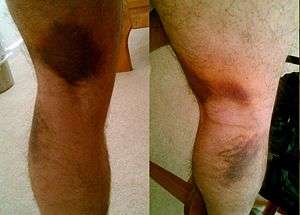Strain (injury)
| Strain (injury) | |
|---|---|
 | |
| Two images of the same strain. One of the pictures was shot through a mirror. | |
| Classification and external resources | |
| Specialty | Emergency medicine |
| ICD-10 | M62.6, T14.3 |
| ICD-9-CM | 848.9 |
| MeSH | D013180 |
A strain is an injury to a muscle in which the muscle fibers tear as a result of overstretching. A strain is also colloquially known as a pulled muscle or torn muscle. The equivalent injury to a ligament is a sprain.[1]
Signs and symptoms
Typical symptoms of a strain include localized stiffness, discoloration and bruising around the strained muscle.
Causes
Strains are a result of muscular fiber tears due to over stretching; they can range from mild annoyance to very painful. Although strains are not restricted to athletes and can happen while doing everyday tasks, people who play sports are more at risk of developing a strain.
Treatment
The first-line treatment for a muscular strain in the acute phase include five steps commonly known as P.R.I.C.E.[2][3]
- Protection: Apply soft padding to minimize impact with objects.
- Rest: Rest is necessary to accelerate healing and reduce the potential for reinjury.
- Ice: Apply ice to reduce swelling by reducing blood flow to the injury site. Never ice for more than 20 minutes at a time.
- Compression: Wrap the strained area to reduce swelling with a soft-wrapped bandage.
- Elevation: Keep the strained area as close to the level of the heart as is conveniently possible to keep blood from pooling in the injured area.
The ice and compression (cold compression therapy) will stop the pain and swelling while the injury starts to heal itself. Controlling the inflammation is critical to the healing process, and the icing further restricts fluid leaking into the injured area as well as controlling pain.
Cold compression therapy wraps are a useful way to combine icing and compression to stop swelling and pain.
This immediate treatment is usually accompanied by the use of nonsteroidal anti-inflammatory drugs[4] (e.g., ibuprofen), which both reduce the immediate inflammation and relieve pain. However, NSAIDs, including aspirin and ibuprofen, affect platelet function (this is why they are known as "blood thinners") and should not be taken during the period when tissue is bleeding because they will tend to increase blood flow, inhibit clotting, and thereby increase bleeding and swelling. After the bleeding has stopped, NSAIDs can be used with some effectiveness to reduce inflammation and pain.
It is recommended[5] that the person injured should consult a medical provider if the injury is accompanied by severe pain, if the limb cannot be used, or if there is noticeable tenderness over an isolated spot. These can be signs of a broken or fractured bone, a sprain, or a complete muscle tear.
See also
References
- ↑ Fitness For Dummies p 60, Suzanne Schlosberg, Liz Neporent, For Dummies, 2005, ISBN 0-7645-7851-0
- ↑ MedicalMnemonics.com: 235
- ↑ T. A. Järvinen, et al., "Muscle injuries: optimising recovery" , Best Pract Res Clin Rheumatol., 21 (2) Apr 2007, pp. 317-31.
- ↑ TJ Noonan and WE Garrett, Jr, "Muscle strain injury: diagnosis and treatment," Journal of the American Academy of Orthopaedic Surgeons, 7 (4), Jul-Aug 1999, pp. 262-9, see web version (accessed Aug. 25, 2008)
- ↑ R. Neustaedter, "Natural Treatment for Injuries" (accessed Aug. 25, 200
External links
- Questions and Answers about Sprains and Strains - US National Institute of Arthritis and Musculoskeletal and Skin Diseases